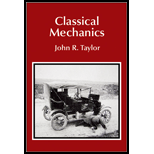
Concept explainers
(a)
Show that
(a)
Answer to Problem 7.49P
It is proved that
Explanation of Solution
Write the expression vector potential.
Here,
Take curl of above equation on both sides.
Write the expression for radial vector.
Take divergence of above equation on both sides.
Write the general vector form of magnetic field in cartesian coordinate system.
Find the value of
Find
Conclusion:
Substitute 3 for
Thus, it is proved that
Write the expression for
Write the expression for
Following values can be obtained using the above equation.
Substitute
Thus, it is proved that
Thus, it is proved that
(b)
Give Lagrangian function in cylindrical polar coordinates and corresponding three Lagrange equations.
(b)
Answer to Problem 7.49P
Cylindrical form of Lagrangian is
Explanation of Solution
Write the expression for kinetic energy.
Here,
Write the expression for potential energy.
Here,
Write the equation for Lagrangian function.
Substitute
Write the equation for
Rewrite the equation for
Substitute
Differentiate the above equation with respect to
Differentiate the equation
Differentiate the above equation with respect to t.
Differentiate equation (I) with respect to
Differentiate equation (I) with respect to
Differentiate equation (I) with respect to
Differentiate equation (I) with respect to
Write the Lagrangian equation for
Thus, the Lagrange equation for
Write the Lagrangian equation for
Substitute equation (III) in the above equation.
Thus, the Lagrange equation for
Write the Lagrangian equation for z.
Substitute equation (IV) in the above equation.
Thus, the cylindrical form of Lagrangian is
(c)
Explain in detail about the solutions which includes
(c)
Answer to Problem 7.49P
Solutions which includes
Explanation of Solution
Since
Its second derivative will be also zero.
Rewrite the equation
Solutions of above equation is as follows.
Therefore, as
Want to see more full solutions like this?
Chapter 7 Solutions
Classical Mechanics
 College PhysicsPhysicsISBN:9781305952300Author:Raymond A. Serway, Chris VuillePublisher:Cengage Learning
College PhysicsPhysicsISBN:9781305952300Author:Raymond A. Serway, Chris VuillePublisher:Cengage Learning University Physics (14th Edition)PhysicsISBN:9780133969290Author:Hugh D. Young, Roger A. FreedmanPublisher:PEARSON
University Physics (14th Edition)PhysicsISBN:9780133969290Author:Hugh D. Young, Roger A. FreedmanPublisher:PEARSON Introduction To Quantum MechanicsPhysicsISBN:9781107189638Author:Griffiths, David J., Schroeter, Darrell F.Publisher:Cambridge University Press
Introduction To Quantum MechanicsPhysicsISBN:9781107189638Author:Griffiths, David J., Schroeter, Darrell F.Publisher:Cambridge University Press Physics for Scientists and EngineersPhysicsISBN:9781337553278Author:Raymond A. Serway, John W. JewettPublisher:Cengage Learning
Physics for Scientists and EngineersPhysicsISBN:9781337553278Author:Raymond A. Serway, John W. JewettPublisher:Cengage Learning Lecture- Tutorials for Introductory AstronomyPhysicsISBN:9780321820464Author:Edward E. Prather, Tim P. Slater, Jeff P. Adams, Gina BrissendenPublisher:Addison-Wesley
Lecture- Tutorials for Introductory AstronomyPhysicsISBN:9780321820464Author:Edward E. Prather, Tim P. Slater, Jeff P. Adams, Gina BrissendenPublisher:Addison-Wesley College Physics: A Strategic Approach (4th Editio...PhysicsISBN:9780134609034Author:Randall D. Knight (Professor Emeritus), Brian Jones, Stuart FieldPublisher:PEARSON
College Physics: A Strategic Approach (4th Editio...PhysicsISBN:9780134609034Author:Randall D. Knight (Professor Emeritus), Brian Jones, Stuart FieldPublisher:PEARSON





